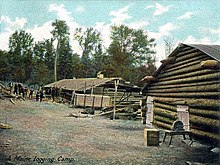History

Lifestyleedit
Lumberjacks worked in lumber camps and often lived a migratory life, following timber harvesting jobs as they opened. Being a lumberjack was seasonal work. Lumberjacks were exclusively men. They usually lived in bunkhouses or tents. Common equipment included the axe and cross-cut saw. Lumberjacks could be found wherever there were vast forests to be harvested and a demand for wood, most likely in Scandinavia, Canada, and parts of the United States. In the U.S., many lumberjacks were of Scandinavian ancestry, continuing the family tradition. American lumberjacks were first centred in north-eastern states such as Maine. They then followed the general westward migration on the continent to the Upper Midwest, and finally the Pacific Northwest. Stewart Holbrook documented the emergence and westward migration of the classic American lumberjack in his first book, Holy Old Mackinaw: A Natural History of the American Lumberjack. He often wrote colourfully about lumberjacks in his subsequent books, romanticizing them as hard-drinking, hard-working men. Logging camps were slowly phased out between World War II and the early 1960s as crews could by then be transported to remote logging sites in motor vehicles.
Division of labouredit
The division of labour in lumber camps led to several specialized jobs on logging crews, such as whistle punk, chaser, and high climber. The whistle punk's job was to sound a whistle (usually at the Steam donkey) as a signal to the yarder operator controlling the movement of logs. He also had to act as a safety lookout. A good whistle punk had to be alert and think fast as the safety of the others depended on him. The high climber (also known as a tree topper) used iron climbing hooks and rope to ascend a tall tree in the landing area of the logging site, where he would chop off limbs as he climbed, chop off the top of the tree, and finally attach pulleys and rigging to the tree. After that, it could be used as a spar so logs could be skidded into the landing. High climbers and whistle punks were both phased out in the 1960s to early 1970s when portable steel towers replaced spar trees and radio equipment replaced steam whistles for communication. The choker setters attached steel cables (or chokers) to downed logs so they could be dragged into the landing by the yarder. The chasers removed the chokers once the logs were at the landing. Choker setters and chasers were often entry-level positions on logging crews, with more experienced loggers seeking to move up to more skill-intensive positions such as yarder operator and high climber, or supervisory positions such as hook tender. Despite the common perception that all loggers cut trees, the actual felling and bucking of trees were also specialized job positions done by fallers and buckers. Faller and bucker were once two separate job titles, but they are now combined.
Machineryedit
Before the era of modern diesel or gasoline powered equipment, the existing machinery was steam powered. Animal or steam-powered skidders could be used to haul harvested logs to nearby rail roads for shipment to sawmills. Horse driven logging wheels were a means used for moving logs out of the woods. Another way for transporting logs to sawmills was to float them down a body of water or a specially-constructed log flume. Log rolling, the art of staying on top of a floating log while "rolling" the log by walking, was another skill much in demand among lumberjacks. Spiked boots known as "caulks" or "corks" were used for log rolling and often worn by lumberjacks as their regular footwear.
The term "skid row", which today means a poor city neighbourhood frequented by homeless people, originated in a way in which harvested logs were once transported. Logs could be "skidded" down hills or along a corduroy road. One such street in Seattle was named Skid Road. This street later became frequented by people down on their luck, and both the name and its meaning morphed into the modern term.
Among the living history museums that preserve and interpret the forest industry are:
- BC Forest Discovery Centre, Duncan
- Camp Five Museum, Laona, Wisconsin
- The Lumberjack Steam Train, a passenger excursion train, operates as part of the museum.
- Central New Brunswick Woodsmen's Museum, Boiestown, New Brunswick
- Coos County Logging Museum, Myrtle Point, Oregon
- Cradle of Forestry in America historic site, near Asheville, North Carolina
- Forest History Center, Grand Rapids, Minnesota
- Hartwick Pines Logging Museum, near Grayling, Michigan
- Lumberman's Monument, near Oscoda, Michigan
- Maine Forest & Logging Museum, Bradley, Maine
- Pennsylvania Lumber Museum, near Galeton, Pennsylvania
- Algonquin Logging Museum in Algonquin Provincial Park, Ontario
Comments
Post a Comment